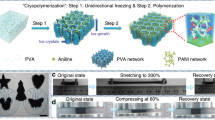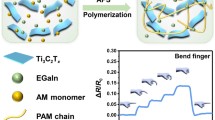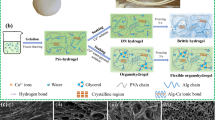Abstract
Stretchable ionic conductors with high transparency and excellent resilience are highly desired for flexible electronics, but traditional ionic conductive hydrogels are easy to dry and freeze. Herein, a newly hybrid crosslinking strategy is presented for preparing a stretchable and transparent hydrogel by using sodium alginate (SA) and acrylamide based on the unique physically and covalently hybrid crosslinking mechanism, which is transformed into organohydrogel by simple solvent replacement. Due to the combination of hybrid crosslinking double network and hydrogen bond interactions introduced by the glycerin-water binary solvent, the SA-poly (acrylamide)-organohydrogel (SPOH) demonstrates excellent anti-freezing (−20°C) property, stability (>2 days), transparency, stretchability (∼1600%) and high ionic conductivity (17.1 mS cm−1). Thus, a triboelectric nanogenerator made from SPOH (O-TENG) shows an instantaneous peak power density of 262 mW m−2 at a load resistance of 10 M∛ and efficiently harvests biomechanical energy to drive an electronic watch and light-emitting diode. Moreover, The O-TENG exhibits favorable long-term stability (2 weeks) and temperature tolerance (-20°C). In addition, the raw materials can be prepared into SPOH fibers by a simple tubular mold method, exhibiting high transparency, which can be used for laser transmission. The various abilities of the SPOH promise the application of energy harvesting and laser transmission for wearable electronics and biomedical field.
摘要
柔性电子产品非常需要具有高透明度和出色回弹性的可拉伸离子导体, 但传统的离子导电水凝胶易于干燥和冻结. 在此, 基于独特的物理和共价杂化交联机制, 我们提出了一种新的杂化交联策略, 用海藻酸钠(SA)和丙烯酰胺(AM)制备可拉伸和透明的水凝胶(SPH), 并通过简单的溶剂置换方法将其转化为有机水凝胶. 所得SA-PAM-有机水凝胶(SPOH)表现出出色的综合性能, 如优异的抗冻性能(−20°C)、 高稳定性(>2天)、 高透明度、 优异的可拉伸性(∼1600%)和高离子电导率(17.1 mS cm−1). 因此, 由SPOH构筑的摩擦纳米发电机(O-TENG)在10 M∛的负载下显示出262 mW m−2的瞬时峰值功率密度, 并且能有效地收集人体运动产生的机械能来驱动电子手表和发光二极管. 此外, O-TENG表现出良好的长期稳定性(2周)和温度耐受性(−20°C). 另外, 该原料可以通过简单的管状模具法制备成柔性有机水凝胶纤维, 该纤维具有高透明度, 可用于传输激光. 该多功能有机水凝胶具有能量收集和激光传输的应用前景, 有望用于可穿戴电子和生物医学领域.
Similar content being viewed by others
References
Keplinger C, Sun JY, Foo CC, et al. Stretchable, transparent, ionic conductors. Science, 2013, 341: 984–987
Rogers JA, Someya T, Huang Y. Materials and mechanics for stretchable electronics. Science, 2010, 327: 1603–1607
Yao S, Zhu Y. Nanomaterial-enabled stretchable conductors: Strategies, materials and devices. Adv Mater, 2015, 27: 1480–1511
Chen D, Liang J, Pei Q. Flexible and stretchable electrodes for next generation polymer electronics: A review. Sci China Chem, 2016, 59: 659–671
Zhou J, Yu H, Xu X, et al. Ultrasensitive, stretchable strain sensors based on fragmented carbon nanotube papers. ACS Appl Mater Interfaces, 2017, 9: 4835–4842
Li Q, Ding C, Yuan W, et al. Highly stretchable and permeable conductors based on shrinkable electrospun fiber mats. Adv Fiber Mater, 2021, 3: 302–311
Watanabe M, Shirai H, Hirai T. Wrinkled polypyrrole electrode for electroactive polymer actuators. J Appl Phys, 2002, 92: 4631–4637
Hong S, Lee H, Lee J, et al. Highly stretchable and transparent metal nanowire heater for wearable electronics applications. Adv Mater, 2015, 27: 4744–4751
Won P, Park JJ, Lee T, et al. Stretchable and transparent kirigami conductor of nanowire percolation network for electronic skin applications. Nano Lett, 2019, 19: 6087–6096
Lee H, Hong S, Lee J, et al. Highly stretchable and transparent supercapacitor by Ag-Au core-shell nanowire network with high electrochemical stability. ACS Appl Mater Interfaces, 2016, 8: 15449–15458
Moon H, Lee H, Kwon J, et al. Ag/Au/polypyrrole core-shell nanowire network for transparent, stretchable and flexible supercapacitor in wearable energy devices. Sci Rep, 2017, 7: 41981
Jung J, Lee H, Ha I, et al. Highly stretchable and transparent electromagnetic interference shielding film based on silver nanowire percolation network for wearable electronics applications. ACS Appl Mater Interfaces, 2017, 9: 44609–44616
Wang J, Yan C, Kang W, et al. High-efficiency transfer of percolating nanowire films for stretchable and transparent photodetectors. Nanoscale, 2014, 6: 10734–10739
Park S, Parida K, Lee PS. Deformable and transparent ionic and electronic conductors for soft energy devices. Adv Energy Mater, 2017, 7: 1701369
Yang CH, Chen B, Zhou J, et al. Electroluminescence of giant stretchability. Adv Mater, 2016, 28: 4480–4484
Zhang P, Guo W, Guo ZH, et al. Dynamically crosslinked dry ion-conducting elastomers for soft iontronics. Adv Mater, 2021, 33: 2101396
Zhang X, Sheng N, Wang L, et al. Supramolecular nanofibrillar hydrogels as highly stretchable, elastic and sensitive ionic sensors. Mater Horiz, 2019, 6: 326–333
Li T, Wang Y, Li S, et al. Mechanically robust, elastic, and healable ionogels for highly sensitive ultra-durable ionic skins. Adv Mater, 2020, 32: 2002706
Guo T, Zhou D, Liu W, et al. Recent advances in all-in-one flexible supercapacitors. Sci China Mater, 2021, 64: 27–45
Zhang Y, Li Y, Liu W. Dipole-dipole and H-bonding interactions significantly enhance the multifaceted mechanical properties of thermo-responsive shape memory hydrogels. Adv Funct Mater, 2015, 25: 471–480
Yang B, Yuan W. Highly stretchable and transparent double-network hydrogel ionic conductors as flexible thermal-mechanical dual sensors and electroluminescent devices. ACS Appl Mater Interfaces, 2019, 11: 16765–16775
Gao Y, Shi L, Lu S, et al. Highly stretchable organogel ionic conductors with extreme-temperature tolerance. Chem Mater, 2019, 31: 3257–3264
Zhang XF, Ma X, Hou T, et al. Inorganic salts induce thermally reversible and anti-freezing cellulose hydrogels. Angew Chem Int Ed, 2019, 58: 7366–7370
Ying B, Chen RZ, Zuo R, et al. An anti-freezing, ambient-stable and highly stretchable ionic skin with strong surface adhesion for wearable sensing and soft robotics. Adv Funct Mater, 2021, 31: 2104665
Bai J, Wang R, Ju M, et al. Facile preparation and high performance of wearable strain sensors based on ionically cross-linked composite hydrogels. Sci China Mater, 2021, 64: 942–952
Morelle XP, Illeperuma WR, Tian K, et al. Highly stretchable and tough hydrogels below water freezing temperature. Adv Mater, 2018, 30: 1801541
Sun L, Chen S, Guo Y, et al. Ionogel-based, highly stretchable, transparent, durable triboelectric nanogenerators for energy harvesting and motion sensing over a wide temperature range. Nano Energy, 2019, 63: 103847
Han L, Liu K, Wang M, et al. Mussel-inspired adhesive and conductive hydrogel with long-lasting moisture and extreme temperature tolerance. Adv Funct Mater, 2018, 28: 1704195
Chen F, Zhou D, Wang J, et al. Rational fabrication of anti-freezing, non-drying tough organohydrogels by one-pot solvent displacement. Angew Chem Int Ed, 2018, 57: 6568–6571
Sun H, Zhao Y, Jiao S, et al. Environment tolerant conductive nanocomposite organohydrogels as flexible strain sensors and power sources for sustainable electronics. Adv Funct Mater, 2021, 31: 2101696
Shi S, Peng X, Liu T, et al. Facile preparation of hydrogen-bonded supramolecular polyvinyl alcohol-glycerol gels with excellent thermoplasticity and mechanical properties. Polymer, 2017, 111: 168–176
Sun JY, Zhao X, Illeperuma WRK, et al. Highly stretchable and tough hydrogels. Nature, 2012, 489: 133–136
Yang Y, Wang X, Yang F, et al. Highly elastic and ultratough hybrid ionic-covalent hydrogels with tunable structures and mechanics. Adv Mater, 2018, 30: 1707071
Zeng L, He J, Cao Y, et al. Tissue-adhesive and highly mechanical double-network hydrogel for cryopreservation and sustained release of anti-cancer drugs. Smart Mater Med, 2021, 2: 229–236
Mo F, Wang Z, Jiang R, et al. Energy-dissipative dual-crosslinked hydrogels for dynamically super-tough sensors. Sci China Mater, 2021, 64: 2764–2776
Zhao Y, Nakajima T, Yang JJ, et al. Proteoglycans and glycosaminoglycans improve toughness of biocompatible double network hydrogels. Adv Mater, 2014, 26: 436–442
Li J, Illeperuma WRK, Suo Z, et al. Hybrid hydrogels with extremely high stiffness and toughness. ACS Macro Lett, 2014, 3: 520–523
Song J, Chen S, Sun L, et al. Mechanically and electronically robust transparent organohydrogel fibers. Adv Mater, 2020, 32: 1906994
Mo F, Liang G, Wang D, et al. Biomimetic organohydrogel electrolytes for high-environmental adaptive energy storage devices. EcoMat, 2019, 1: e12008
Wu J, Wu Z, Wei Y, et al. Ultrasensitive and stretchable temperature sensors based on thermally stable and self-healing organohydrogels. ACS Appl Mater Interfaces, 2020, 12: 19069–19079
Huang H, Han L, Li J, et al. Super-stretchable, elastic and recoverable ionic conductive hydrogel for wireless wearable, stretchable sensor. J Mater Chem A, 2020, 8: 10291–10300
Keller A, Pham J, Warren H, et al. Conducting hydrogels for edible electrodes. J Mater Chem B, 2017, 5: 5318–5328
Liu C, Xu W, Mei C, et al. A chemically self-charging flexible solid-state zinc-ion battery based on VO2 cathode and polyacrylamide-chitin nanofiber hydrogel electrolyte. Adv Energy Mater, 2021, 11: 2003902
Guo WY, Yuan Q, Huang LZ, et al. Multifunctional bacterial cellulose-based organohydrogels with long-term environmental stability. J Colloid Interface Sci, 2022, 608: 820–829
Liu X, Qin J, Wang J, et al. Robust conductive organohydrogel strain sensors with wide range linear sensing, UV filtering, anti-freezing and water-retention properties. Colloids Surfs A-Physicochem Eng Aspects, 2022, 632: 127823
Xie Z, Li H, Mi HY, et al. Freezing-tolerant, widely detectable and ultrasensitive composite organohydrogel for multiple sensing applications. J Mater Chem C, 2021, 9: 10127–10137
Chen J, Shi D, Yang Z, et al. Hand-extended noodle inspired physical conjoined-network organohydrogels with anti-freezing, high stiffness and toughness properties. J Mater Sci, 2021, 56: 8887–8899
Zha XJ, Zhang ST, Pu JH, et al. Nanofibrillar poly(vinyl alcohol) ionic organohydrogels for smart contact lens and human-interactive sensing. ACS Appl Mater Interfaces, 2020, 12: 23514–23522
Qin Z, Sun X, Zhang H, et al. A transparent, ultrastretchable and fully recyclable gelatin organohydrogel based electronic sensor with broad operating temperature. J Mater Chem A, 2020, 8: 4447–4456
Li Q, Chen J, Zhang Y, et al. Superelastic, antifreezing, antidrying, and conductive organohydrogels for wearable strain sensors. ACS Appl Mater Interfaces, 2021, 13: 51546–51555
Chortos A, Liu J, Bao Z. Pursuing prosthetic electronic skin. Nat Mater, 2016, 15: 937–950
Wang ZL. Triboelectric nanogenerators as new energy technology for self-powered systems and as active mechanical and chemical sensors. ACS Nano, 2013, 7: 9533–9557
Liu T, Liu M, Dou S, et al. Triboelectric-nanogenerator-based soft energy-harvesting skin enabled by toughly bonded elastomer/hydrogel hybrids. ACS Nano, 2018, 12: 2818–2826
Huang LB, Dai X, Sun Z, et al. Environment-resisted flexible high performance triboelectric nanogenerators based on ultrafast self-healing non-drying conductive organohydrogel. Nano Energy, 2021, 82: 105724
Park S, Guo Y, Jia X, et al. One-step optogenetics with multifunctional flexible polymer fibers. Nat Neurosci, 2017, 20: 612–619
Yun SH, Kwok SJJ. Light in diagnosis, therapy and surgery. Nat Biomed Eng, 2017, 1: 0008
Choi M, Humar M, Kim S, et al. Step-index optical fiber made of biocompatible hydrogels. Adv Mater, 2015, 27: 4081–4086
Shan D, Zhang C, Kalaba S, et al. Flexible biodegradable citrate-based polymeric step-index optical fiber. Biomaterials, 2017, 143: 142–148
Nazempour R, Zhang Q, Fu R, et al. Biocompatible and implantable optical fibers and waveguides for biomedicine. Materials, 2018, 11: 1283
Choi M, Choi JW, Kim S, et al. Light-guiding hydrogels for cell-based sensing and optogenetic synthesis in vivo. Nat Photon, 2013, 7: 987–994
Acknowledgements
This work was financially supported by the National Natural Science Foundation of China (52002059 and 51872204), the Belt & Road Young Scientist Exchanges Project of Science and Technology Commission Foundation of Shanghai (20520741000), the Fundamental Research Funds for the Central Universities (20D110631), and the State Key Laboratory for Modification of Chemical Fibers and Polymer Materials (Donghua University, KF2019).
Author information
Authors and Affiliations
Contributions
Author contributions Sun W and Zhu L designed the experiments. Zhu L did the experiments and wrote the original draft. Sun W and You Z supervised the study and gave some advice.
Corresponding author
Ethics declarations
Conflict of interest The authors declare that they have no conflict of interest.
Additional information
Supplementary information Supporting data are available in the online version of the paper.
Wei Sun received his BSc and PhD degrees in physics from Tongji University in 2016 and 2019, respectively. In 2019, he joined the State Key Laboratory for Modification of Chemical Fibers and Polymer Materials, College of Material Science and Engineering, Donghua University. His research is mainly focusing on the fabrication and properties of nanobirds, smart (self-healing and elastic) polymers and stretchable energy storage devices.
Zhengwei You is a professor at the State Key Laboratory for Modification of Chemical Fibers and Polymer Materials and the chair of Department of Composite Materials at Donghua University. He currently serves as the director of the Research Base of Textile Materials for Flexible Electronics and Biomedical Applications, China Textile Engineering Society. He received his BSc degree from Shanghai Jiao Tong University and PhD degree from Shanghai Institute of Organic Chemistry. He conducted his postdoctoral research at Georgia Institute of Technology and the University of Pittsburgh. His current research involves smart polymers, biomaterials, 3D printing, and stretchable electronics.
Supporting information
Rights and permissions
About this article
Cite this article
Zhu, L., Xu, J., Song, J. et al. Transparent, stretchable and anti-freezing hybrid double-network organohydrogels. Sci. China Mater. 65, 2207–2216 (2022). https://doi.org/10.1007/s40843-021-1961-1
Received:
Accepted:
Published:
Issue Date:
DOI: https://doi.org/10.1007/s40843-021-1961-1




